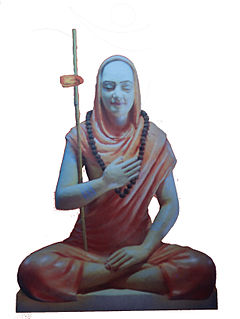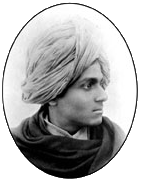
Adi Shankaracharya was an Indian philosopher and theologian who consolidated the doctrine of Advaita Vedanta. He is credited with unifying and establishing the main currents of thought in Hinduism.

Advaita Vedānta is a school of Hindu philosophy, and is a classic system of spiritual realization in Indian tradition. The term Advaita refers to the idea that Brahman alone is ultimately real, the phenomenal transient world is an illusory appearance (maya) of Brahman, and the true self, atman, is not different from Brahman.

Gauḍapāda, also referred as Gauḍapādācārya, was an early medieval era Hindu philosopher and scholar of the Advaita Vedanta school of Hindu philosophy. While details of his biography are uncertain, his ideas inspired others such as Adi Shankara who called him a Paramaguru.

The Vivekachudamani is an introductory treatise within the Advaita Vedanta tradition of Hinduism, traditionally attributed to Adi Shankara of the eighth century. It is in the form of a poem in the Shardula Vikridita metre, and for many centuries has been celebrated as a prakaraṇa grantha of Advaita.

Advaita Ashrama, Mayavati, is a branch of the Ramakrishna Math, founded on 19 March 1899 at the behest of Vivekananda, by his disciples James Henry Sevier, and Charlotte Sevier. Today it publishes the original writings of Vivekananda. As an ashram dedicated to the study and practice of Advaita Vedanta, no images or idols are worshipped there, not even of Ramakrishna; and no images were kept in the premises according to the Ashram ideals set by Vivekananda.

Sister Gargi, born Marie Louise Burke, was a writer and an eminent researcher on Swami Vivekananda, and a leading literary figure of the Ramakrishna-Vivekananda movement. Gargi was introduced to the Ramakrishna-Vivekananda movement in 1948 by Swami Ashokananda. She is known for her six-volume work, Swami Vivekananda in the West: New Discoveries. Her New Discoveries are considered as indispensable for Swami Vivekananda research.

Swarupananda was a direct monastic disciple of Vivekananda and the first president of the Advaita Ashrama, set up by Vivekananda in 1899 at Mayavati, near Champawat. The ashram is a branch of the religious monastic order, Ramakrishna Math, also set up by Vivekananda on the teachings of his guru Ramakrishna.

The Advaita Guru-Paramparā is the traditional list (parampara) of divine, Vedic and historical teachers of Advaita Vedanta. It begins with the Daiva-paramparā, the gods; followed by the Ṛṣi-paramparā, the Vedic seers; and then the Mānava-paramparā, with the historical teachers Gaudapada and Shankara, and four of Shankara's pupils. Of the five contemporary acharyas, the heads of the five Advaita mathas, four acharyas trace their lineage to those four pupils and one to Adi Shankara himself.
Ānanda literally means bliss or happiness. In the Hindu Vedas, Upanishads and Bhagavad gita, ānanda signifies eternal bliss which accompanies the ending of the rebirth cycle. Those who renounce the fruits of their actions and submit themselves completely to the divine will, arrive at the final termination of the cyclical life process (saṃsāra) to enjoy eternal bliss (ānanda) in perfect union with the godhead. The tradition of seeking union with God through loving commitment is referred to as bhakti, or devotion.

Vedantasara, Essence of Vedanta, is a 15th-century Advaita vedanta text written by Sadananda Yogendra Saraswati.
Uparati, is a Sanskrit word and it literally means "cessation, quietism, stopping worldly action". It is an important concept in Advaita Vedanta pursuit of moksha and refers to the ability to achieve "dispassion", and "discontinuation of religious ceremonies".
Bhuman (Sanskrit:भूमन) means fullness or abundance; It is a synonym of Brahman. The word, Bhuman, is derived from the word, Bahu, meaning much or many, with the suffix – imam, added after it by dropping – i, to impart the sense of the abstract noun. This word refers directly to the Supreme Self who is superior to Prana though Prana is Bhuman because of proximity where the vow of Prana, consisting in transcending all other thing is alluded to.
In Advaita Vedanta and Jnana Yoga Nididhyasana is profound and repeated meditation on the mahavakyas, great Upanishadic statements such as "That art Thou", to realize the identity of Atman and Brahman. It is the fourth step in the training of a sisya (disciple), consisting of preparatory practices, listening to the teachings as contained in the sruti, reflection on the teachings, and nididhyasana.

Charlotte Sevier, also known as Mrs. Sevier, was a direct disciple of Swami Vivekananda and was British in origin. She, together with her husband James Henry Sevier established the Advaita Ashrama in Mayavati, a branch of the Ramakrishna Order, in the Himalayas.

Nischayananda was a direct monastic disciple of Vivekananda. He, together with Kalyanananda was responsible for setting up and running the Ramakrishna Mission Sevashrama, Kankhal. He was inspired by Vivekananda's philosophy of serving man as God and dedicated his life to serve poor and downtrodden in the remote areas where no healthcare facility existed. He worked in military service before joining the Ramakrishna Order as a direct monastic disciple of Vivekananda. He met Vivekananda in Madras and decided to become his disciple. After Vivekananda's death, he went for pilgrimage and by chance came to Haridwar where he met his brother disciple Kalyanananda and joined him in carrying out the works of Ramakrishna Mission Sevashrama Kankhal.

Dhanraj Giri (1811–1901) was the abbot of Kailash Ashram, an ashram, which he established in 1880 at Muni Ki Reti, Rishikesh. It was one of the first large ashrams to be established in Rishikesh, prior to which it was mostly as a place for individual seekers, or pilgrims to stop over on way to Char Dham temples pilgrimage. He was a famous monk in Northern India and was a scholar in Vedanta philosophy. He was well acquainted with spiritual luminaries of nineteenth century India like Swami Vivekananda.
Kasaya is attachment to worldly objects and is an obstacle in the path leading to Nirvikalpa Samadhi: it is overcome through viveka, discrimination.
The Sanskrit term, Sāmānādhikaraṇyam (Sanskrit:सामानाधिकरण्यम्), generally refers to – 'identical denotation', 'common substratum' or 'unity of substratum'.
Rasāsvāda means – appreciation, sipping of juice, perception of pleasure; in Indian philosophy, it refers to the taste of bliss in the absence of all thought which is an obstacle in the path leading to Nirvikalpa Samādhi ; it is aesthetic consciousness. Rasasvada means one gets a power of healing or a power of knowing the mind which gives enjoyment but this enjoyment is superficial enjoyment or happiness which should not be sought while seeking Truth.
Viśayah primarily means – 'the sphere of influence or activity', and also refers to – 'dominion', 'kingdom', 'territory', 'country', 'abode', 'lands' etc., but in Hindu philosophy, it has been used to indicate 'the subject matter', 'the sense-objects', 'the subject of interpretation', 'the area or range of words' or 'the field of experience'. According to the Mimamsakas a complete adhikarana (अधिकरणम्) i.e. main, relation or connection, consists of viśayah (विषयः) - the subject or the matter to be explained, viśeya (विशय) or sanśeya (संशय) - the doubt or the question arising upon that matter, pūrvapakśa (पूर्वपक्ष) – the prima facie argument concerning it, uttarpakśa (उत्तर्पक्ष) or siddhanta (सिद्धान्त) – the answer or the demonstrated conclusion, and sangati (संगति) – pertinency or relevancy or the final conclusion. According to Srimad Bhagavatam (XI.ix.29), viśayah or the objects of sense enjoyment are to be found everywhere, as āhāra ('food'), nidrā ('sleep'), bhaya and maithuna.









